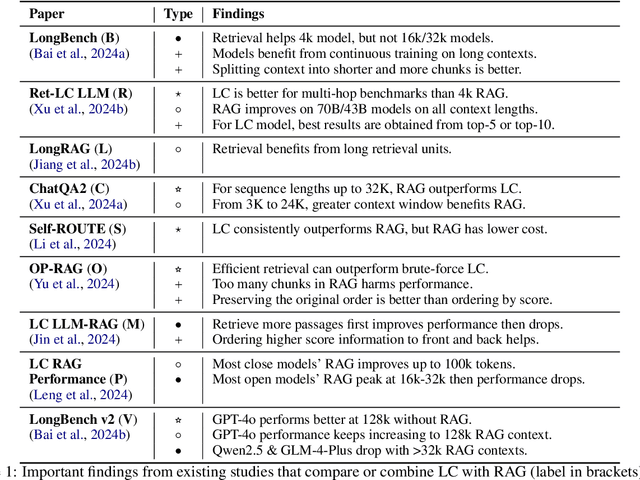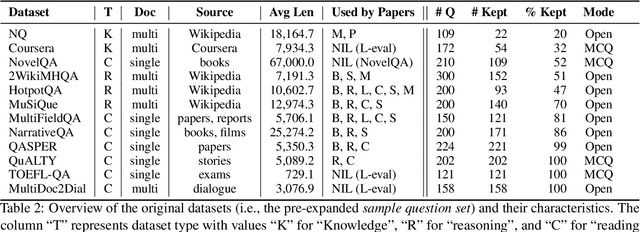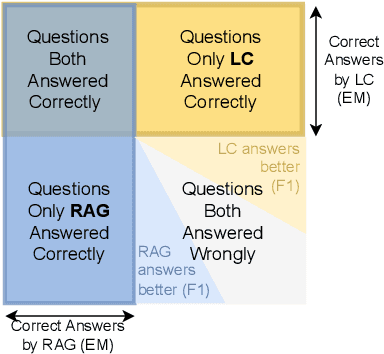Xinze Li
ReCUT: Balancing Reasoning Length and Accuracy in LLMs via Stepwise Trails and Preference Optimization
Jun 12, 2025Abstract:Recent advances in Chain-of-Thought (CoT) prompting have substantially improved the reasoning capabilities of Large Language Models (LLMs). However, these methods often suffer from overthinking, leading to unnecessarily lengthy or redundant reasoning traces. Existing approaches attempt to mitigate this issue through curating multiple reasoning chains for training LLMs, but their effectiveness is often constrained by the quality of the generated data and prone to overfitting. To address the challenge, we propose Reasoning Compression ThroUgh Stepwise Trials (ReCUT), a novel method aimed at balancing the accuracy and length of reasoning trajectory. Specifically, ReCUT employs a stepwise exploration mechanism and a long-short switched sampling strategy, enabling LLMs to incrementally generate diverse reasoning paths. These paths are evaluated and used to construct preference pairs to train two specialized models (Gemini LLMs)-one optimized for reasoning accuracy, the other for shorter reasoning. A final integrated model is obtained by interpolating the parameters of these two models. Experimental results across multiple math reasoning datasets and backbone models demonstrate that ReCUT significantly reduces reasoning lengths by approximately 30-50%, while maintaining or improving reasoning accuracy compared to various baselines. All codes and data will be released via https://github.com/NEUIR/ReCUT.
ClueAnchor: Clue-Anchored Knowledge Reasoning Exploration and Optimization for Retrieval-Augmented Generation
May 30, 2025Abstract:Retrieval-Augmented Generation (RAG) augments Large Language Models (LLMs) with external knowledge to improve factuality. However, existing RAG systems frequently underutilize the retrieved documents, failing to extract and integrate the key clues needed to support faithful and interpretable reasoning, especially in cases where relevant evidence is implicit, scattered, or obscured by noise. To address this issue, we propose ClueAnchor, a novel framework for enhancing RAG via clue-anchored reasoning exploration and optimization. ClueAnchor extracts key clues from retrieved content and generates multiple reasoning paths based on different knowledge configurations, optimizing the model by selecting the most effective one through reward-based preference optimization. Experiments show that ClueAnchor significantly outperforms prior RAG baselines in reasoning completeness and robustness. Further analysis confirms its strong resilience to noisy or partially relevant retrieved content, as well as its capability to identify supporting evidence even in the absence of explicit clue supervision during inference.
EULER: Enhancing the Reasoning Ability of Large Language Models through Error-Induced Learning
May 28, 2025Abstract:Large Language Models (LLMs) have demonstrated strong reasoning capabilities and achieved promising results in mathematical problem-solving tasks. Learning from errors offers the potential to further enhance the performance of LLMs during Supervised Fine-Tuning (SFT). However, the errors in synthesized solutions are typically gathered from sampling trails, making it challenging to generate solution errors for each mathematical problem. This paper introduces the Error-IndUced LEaRning (EULER) model, which aims to develop an error exposure model that generates high-quality solution errors to enhance the mathematical reasoning capabilities of LLMs. Specifically, EULER optimizes the error exposure model to increase the generation probability of self-made solution errors while utilizing solutions produced by a superior LLM to regularize the generation quality. Our experiments across various mathematical problem datasets demonstrate the effectiveness of the EULER model, achieving an improvement of over 4% compared to all baseline models. Further analysis reveals that EULER is capable of synthesizing more challenging and educational solution errors, which facilitate both the training and inference processes of LLMs. All codes are available at https://github.com/NEUIR/EULER.
PoseX: AI Defeats Physics Approaches on Protein-Ligand Cross Docking
May 03, 2025Abstract:Recently, significant progress has been made in protein-ligand docking, especially in modern deep learning methods, and some benchmarks were proposed, e.g., PoseBench, Plinder. However, these benchmarks suffer from less practical evaluation setups (e.g., blind docking, self docking), or heavy framework that involves training, raising challenges to assess docking methods efficiently. To fill this gap, we proposed PoseX, an open-source benchmark focusing on self-docking and cross-docking, to evaluate the algorithmic advances practically and comprehensively. Specifically, first, we curate a new evaluation dataset with 718 entries for self docking and 1,312 for cross docking; second, we incorporate 22 docking methods across three methodological categories, including (1) traditional physics-based methods (e.g., Schr\"odinger Glide), (2) AI docking methods (e.g., DiffDock), (3) AI co-folding methods (e.g., AlphaFold3); third, we design a relaxation method as post-processing to minimize conformation energy and refine binding pose; fourth, we released a leaderboard to rank submitted models in real time. We draw some key insights via extensive experiments: (1) AI-based approaches have already surpassed traditional physics-based approaches in overall docking accuracy (RMSD). The longstanding generalization issues that have plagued AI molecular docking have been significantly alleviated in the latest models. (2) The stereochemical deficiencies of AI-based approaches can be greatly alleviated with post-processing relaxation. Combining AI docking methods with the enhanced relaxation method achieves the best performance to date. (3) AI co-folding methods commonly face ligand chirality issues, which cannot be resolved by relaxation. The code, curated dataset and leaderboard are released at https://github.com/CataAI/PoseX.
Toward Generalizable Evaluation in the LLM Era: A Survey Beyond Benchmarks
Apr 26, 2025Abstract:Large Language Models (LLMs) are advancing at an amazing speed and have become indispensable across academia, industry, and daily applications. To keep pace with the status quo, this survey probes the core challenges that the rise of LLMs poses for evaluation. We identify and analyze two pivotal transitions: (i) from task-specific to capability-based evaluation, which reorganizes benchmarks around core competencies such as knowledge, reasoning, instruction following, multi-modal understanding, and safety; and (ii) from manual to automated evaluation, encompassing dynamic dataset curation and "LLM-as-a-judge" scoring. Yet, even with these transitions, a crucial obstacle persists: the evaluation generalization issue. Bounded test sets cannot scale alongside models whose abilities grow seemingly without limit. We will dissect this issue, along with the core challenges of the above two transitions, from the perspectives of methods, datasets, evaluators, and metrics. Due to the fast evolving of this field, we will maintain a living GitHub repository (links are in each section) to crowd-source updates and corrections, and warmly invite contributors and collaborators.
Judge as A Judge: Improving the Evaluation of Retrieval-Augmented Generation through the Judge-Consistency of Large Language Models
Feb 26, 2025Abstract:Retrieval-Augmented Generation (RAG) has proven its effectiveness in alleviating hallucinations for Large Language Models (LLMs). However, existing automated evaluation metrics cannot fairly evaluate the outputs generated by RAG models during training and evaluation. LLM-based judgment models provide the potential to produce high-quality judgments, but they are highly sensitive to evaluation prompts, leading to inconsistencies when judging the output of RAG models. This paper introduces the Judge-Consistency (ConsJudge) method, which aims to enhance LLMs to generate more accurate evaluations for RAG models. Specifically, ConsJudge prompts LLMs to generate different judgments based on various combinations of judgment dimensions, utilize the judge-consistency to evaluate these judgments and select the accepted and rejected judgments for DPO training. Our experiments show that ConsJudge can effectively provide more accurate judgments for optimizing RAG models across various RAG models and datasets. Further analysis reveals that judgments generated by ConsJudge have a high agreement with the superior LLM. All codes are available at https://github.com/OpenBMB/ConsJudge.
RankCoT: Refining Knowledge for Retrieval-Augmented Generation through Ranking Chain-of-Thoughts
Feb 25, 2025Abstract:Retrieval-Augmented Generation (RAG) enhances the performance of Large Language Models (LLMs) by incorporating external knowledge. However, LLMs still encounter challenges in effectively utilizing the knowledge from retrieved documents, often being misled by irrelevant or noisy information. To address this issue, we introduce RankCoT, a knowledge refinement method that incorporates reranking signals in generating CoT-based summarization for knowledge refinement based on given query and all retrieval documents. During training, RankCoT prompts the LLM to generate Chain-of-Thought (CoT) candidates based on the query and individual documents. It then fine-tunes the LLM to directly reproduce the best CoT from these candidate outputs based on all retrieved documents, which requires LLM to filter out irrelevant documents during generating CoT-style summarization. Additionally, RankCoT incorporates a self-reflection mechanism that further refines the CoT outputs, resulting in higher-quality training data. Our experiments demonstrate the effectiveness of RankCoT, showing its superior performance over other knowledge refinement models. Further analysis reveals that RankCoT can provide shorter but effective refinement results, enabling the generator to produce more accurate answers. All code and data are available at https://github.com/NEUIR/RankCoT.
HIPPO: Enhancing the Table Understanding Capability of Large Language Models through Hybrid-Modal Preference Optimization
Feb 24, 2025Abstract:Tabular data contains rich structural semantics and plays a crucial role in organizing and manipulating information. To better capture these structural semantics, this paper introduces the HybrId-modal Preference oPtimizatiOn (HIPPO) model, which represents tables using both text and image, and optimizes MLLMs to effectively learn more comprehensive table information from these multiple modalities. Specifically, HIPPO samples model responses from hybrid-modal table representations and designs a modality-consistent sampling strategy to enhance response diversity and mitigate modality bias during DPO training. Experimental results on table question answering and table fact verification tasks demonstrate the effectiveness of HIPPO, achieving a 4% improvement over various table reasoning models. Further analysis reveals that HIPPO not only enhances reasoning abilities based on unimodal table representations but also facilitates the extraction of crucial and distinct semantics from different modal representations. All data and codes are available at https://github.com/NEUIR/HIPPO.
AI Explainability for Power Electronics: From a Lipschitz Continuity Perspective
Jan 17, 2025Abstract:Lifecycle management of power converters continues to thrive with emerging artificial intelligence (AI) solutions, yet AI mathematical explainability remains unexplored in power electronics (PE) community. The lack of theoretical rigor challenges adoption in mission-critical applications. Therefore, this letter proposes a generic framework to evaluate mathematical explainability, highlighting inference stability and training convergence from a Lipschitz continuity perspective. Inference stability governs consistent outputs under input perturbations, essential for robust real-time control and fault diagnosis. Training convergence guarantees stable learning dynamics, facilitating accurate modeling in PE contexts. Additionally, a Lipschitz-aware learning rate selection strategy is introduced to accelerate convergence while mitigating overshoots and oscillations. The feasibility of the proposed Lipschitz-oriented framework is demonstrated by validating the mathematical explainability of a state-of-the-art physics-in-architecture neural network, and substantiated through empirical case studies on dual-active-bridge converters. This letter serves as a clarion call for the PE community to embrace mathematical explainability, heralding a transformative era of trustworthy and explainable AI solutions that potentially redefine the future of power electronics.
Long Context vs. RAG for LLMs: An Evaluation and Revisits
Dec 27, 2024



Abstract:Extending context windows (i.e., Long Context, LC) and using retrievers to selectively access relevant information (i.e., Retrieval-Augmented Generation, RAG) are the two main strategies to enable LLMs to incorporate extremely long external contexts. This paper revisits recent studies on this topic, highlighting their key insights and discrepancies. We then provide a more comprehensive evaluation by filtering out questions answerable without external context, identifying the most effective retrieval methods, and expanding the datasets. We show that LC generally outperforms RAG in question-answering benchmarks, especially for Wikipedia-based questions. Summarization-based retrieval performs comparably to LC, while chunk-based retrieval lags behind. However, RAG has advantages in dialogue-based and general question queries. These insights underscore the trade-offs between RAG and LC strategies, offering guidance for future optimization of LLMs with external knowledge sources. We also provide an in-depth discussion on this topic, highlighting the overlooked importance of context relevance in existing studies.
 Add to Chrome
Add to Chrome Add to Firefox
Add to Firefox Add to Edge
Add to Edge